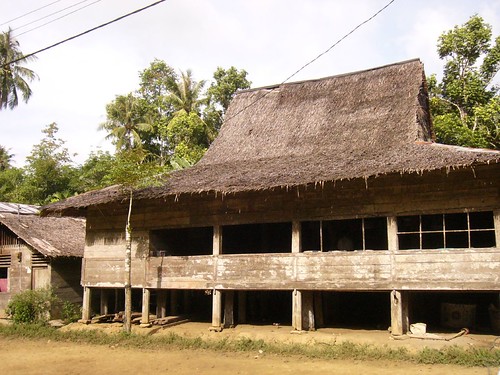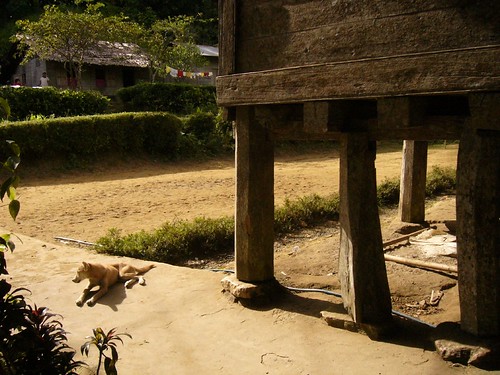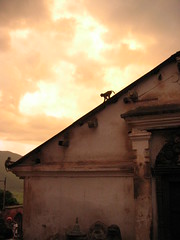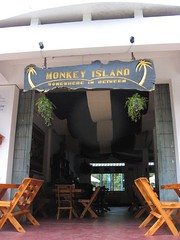They don't build 'em like they used to
In my recent trip to Nias, an island off the west coast of Sumatra which was recently hit by a series of earthquake and of course the 2004 tsunami, we were told that some traditional architecture withstood the test of nature.
In fact, these architecture were so fantastic that it attest to the traditional indigenous knowledge of the people on the island. They were familiar with the concept of earthquake-proofing their homes.
Unfortunately, these homes are no longer built on the island due to the loss of knowledge and the lack of materials. I guess each house would require the depletion of a good piece of primary hardwood forest.

There are two designs, representative of architecture from different parts of the island. At this point in time I cannot remember which is from the south and which from the north.

One has a roundish design and one a squarish one. Personally I prefer the round one. Of course they are on stilts. And if you look closely at the round one, not only are they on thick trunk stilts, they are also crossed and double crossed at the bottom which make for very stable foundations.
None of these houses were reported to have collapsed during the multiple earthquakes over the last 2 years.
Unfortunately these houses are expensive to maintain and when we interviewed the homeowners, they reported that the houses were built in the times of their grandparents about 2-3 generations ago and now nobody knows how to do it and also do not know why the houses were built on stilts or in the manner that it is. In fact, the grandma from the square house said that his grandfather built the house himself. Now they just reguarly replace the the thatch roof and it's as much as they can do. Did I mention that I heard these homes were built without nails?

How long will these informed and intelligent, tried-and-tested-against-time architecture last on the surface of this earth? In Thailand, researchers are helping to preserve traditional architecture and building method by having the last of the men with the knowhow to teach them to scientists and academics who would then record them down and for the technique to remain for future generations. However, even in Penang, when I visited the building guild, the beautiful nail-less wooden sedans and intricate constructions built generations ago are now rotting away in a little room with none of the guild members able to reconstruct or replicate its grandeur.
Why do we often let these knowledge slip through our fingers and not realizing, or perhaps never realizing even after it's too late.
In fact, these architecture were so fantastic that it attest to the traditional indigenous knowledge of the people on the island. They were familiar with the concept of earthquake-proofing their homes.
Unfortunately, these homes are no longer built on the island due to the loss of knowledge and the lack of materials. I guess each house would require the depletion of a good piece of primary hardwood forest.

There are two designs, representative of architecture from different parts of the island. At this point in time I cannot remember which is from the south and which from the north.

One has a roundish design and one a squarish one. Personally I prefer the round one. Of course they are on stilts. And if you look closely at the round one, not only are they on thick trunk stilts, they are also crossed and double crossed at the bottom which make for very stable foundations.
None of these houses were reported to have collapsed during the multiple earthquakes over the last 2 years.
Unfortunately these houses are expensive to maintain and when we interviewed the homeowners, they reported that the houses were built in the times of their grandparents about 2-3 generations ago and now nobody knows how to do it and also do not know why the houses were built on stilts or in the manner that it is. In fact, the grandma from the square house said that his grandfather built the house himself. Now they just reguarly replace the the thatch roof and it's as much as they can do. Did I mention that I heard these homes were built without nails?

How long will these informed and intelligent, tried-and-tested-against-time architecture last on the surface of this earth? In Thailand, researchers are helping to preserve traditional architecture and building method by having the last of the men with the knowhow to teach them to scientists and academics who would then record them down and for the technique to remain for future generations. However, even in Penang, when I visited the building guild, the beautiful nail-less wooden sedans and intricate constructions built generations ago are now rotting away in a little room with none of the guild members able to reconstruct or replicate its grandeur.
Why do we often let these knowledge slip through our fingers and not realizing, or perhaps never realizing even after it's too late.











0 Comments:
Post a Comment
<< Home